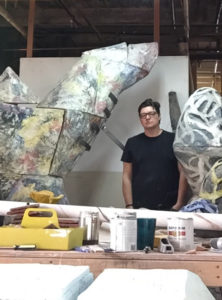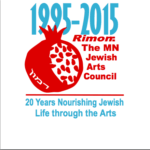I first met Jeffrey Haddorff , a Twin Cities-based ceramic sculptor, when we exhibited our work together in Lyrical Narratives at the Tychman Shapiro Gallery in 2014. I was impressed by the scale of his work and drawn to the bold, beautiful forms, at once confident and whimsical, sculpted entirely in clay.
You can’t help but be drawn in by these forms looming large over the viewer. Massive and sturdy, they appear to be just barely hanging on, precarious. It is a feeling corroborated by the metal supports holding the structures in place.
Jeffrey told me he begins his sculptural process with drawings of shapes, first small, then to scale. The shapes are built in clay, and fired one by one in a kiln—a special furnace heated at a very high temperature in which clay is hardened and dried. They are then constructed into a single structure, painted with numerous layers of glazes, taken apart and kiln fired for a second time. Once reassembled, metal supports are fabricated and painted. The result is a rich and robust sculpture that bears the imprint of the artist’s hand.
Interested in the imprint of the artist’s mind, I spoke with him about his inspiration, process and connection to Judaism:
How does your Jewish identity factor in your artwork in terms of imagery, themes, material, or process?
It manifests itself in the approach to making work. One of the beautiful things about Judaism is the lifecycle events: Shabbat, marking time, and being aware as you are moving through life of the world around you and the people around you. For me, making art is part of that. Art serves as a marker: the things that I made years ago represent where I was at that point in my life, and act as a point of reference, making me aware of where I am now.
You are coming out of a tradition of ceramics, yet you are a sculptor, not a potter. Where do you see yourself in the larger context of art history, and in a particular tradition?
I have an awkward relationship with ceramics. I am an artist and not necessarily a ceramicist. My education was making meaningful objects out of clay, in a centuries-old tradition of global pottery production. I am inspired by makers who have revealed endless creative possibilities—ceramic artists, painters, sculptors, musicians, writers like Kurt Vonnegut and David Foster Wallace.
What contemporary artists have influenced your work?
I am attracted to the boldness, bigness, and physicality of Julian Schnabel’s work; Curtis Hoard, my teacher in the MFA program at the University of Minnesota, continues to be a mentor.
How does the actual material, clay, influence your process and imagery?
Initially, the size of the kiln was a restriction, so I avoided making large pieces. Now, I have turned that parameter into a positive, becoming an integral part of the work. For the past five or six years I have been working on a large scale. The process is physical; I use slabs of clay that weigh 25 pounds and throw them on the ground to flatten them, wearing down the concrete floors in my studio in the process. Even though the work is big, there is an intimacy in working with your hands and leaving marks with your hands, feet, and floor, as clay absorbs all those things and records them. As an artist I am constantly making choices: to obliterate that mark or leave it there, alter it, add to it. Through the dynamic process of shaping, firing, and painting, the clay moves, shifts, and twists, and I can control that or give the material the opportunity to do something.
Jeffrey’s work is now on view in the main lobby of Mayo Clinic Square, 600 Hennepin Avenue, Minneapolis, until March 30th as part of the Made Here initiative. A project of Hennepin Theatre Trust, Made Here is a walkable urban art experience throughout downtown Minneapolis. This initiative aims to bring the art from the confines of the studio and gallery space and into the public realm, accessible and available for all to enjoy.
For more information, visit Jeffrey’s website at www.jeffreyhaddorff.com
For more on Made Here artists visit www.madeheremn.org/showcases
This interview was made possible in part with support from the Howard B. & Ruth F. Brin Jewish Arts Endowment, a fund of the Minneapolis Jewish Federation’s Foundation, and Rimon: The Minnesota Jewish Arts Council, an initiative of the Minneapolis Jewish Federation.





